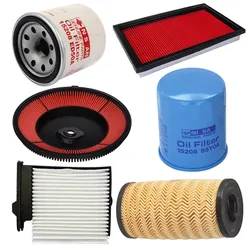Troubleshooting and Maintaining Oil Filters
2024-10-28
What are signs of a bad oil filter?
Common symptoms include:
Low oil pressure warning light on your dashboard.
Strange engine noises like knocking or ticking.
Poor acceleration and decreased fuel efficiency.
Oil leaks around the filter area.
Dark, thick oil that appears dirty when checked with a dipstick.
How do I know if my oil filter is clogged?
A clogged oil filter can restrict oil flow, causing:
1. Warning lights—Look for the low oil pressure indicator.
2. Oil leaks around the filter seal due to pressure buildup.
3. Overheating engine caused by poor lubrication.
4. Reduced engine performance or sluggish behavior during acceleration.
Can I replace the oil filter myself?
Yes! Here’s how to change it:
1. Drain the old oil: Place a pan under the oil drain plug and remove it.
2. Remove the old filter: Use an oil filter wrench to unscrew the filter.
3. Prepare the new filter: Apply a thin layer of oil to the gasket to ensure a good seal.
4. Install the new filter: Tighten it by hand, then give it a slight turn with the wrench.
5. Add new oil: Refill with the recommended oil and check for leaks.
Can I reuse an oil filter?
No, oil filters are designed for single use. Reusing a filter can lead to contamination and clogging, reducing the engine's efficiency and causing damage. Always replace the filter with each oil change.
What’s the difference between a cheap and a premium oil filter?
Premium filters offer better construction and filtration, including:
High-quality materials like synthetic media for finer filtering.
Longer lifespan, which is ideal for synthetic oil changes.
Better seals that reduce the risk of leaks.
Cheaper filters may use paper-based media that can break down quickly, resulting in poor performance over time. For high-performance or long-interval oil changes, premium filters are recommended.
What are the environmental concerns with oil filters?
Used oil filters contain contaminated oil, which can harm the environment if disposed of improperly. Here’s how to dispose of them responsibly:
Drain the oil from the filter for several hours before disposal.
Recycle the filter at a certified recycling center or auto shop.
Follow local regulations for hazardous waste disposal.
How can I extend the life of my oil filter?
1. Use high-quality engine oil to reduce contamination buildup.
2. Avoid harsh driving conditions that generate excess debris and wear.
3. Check for oil leaks regularly, as leaks can compromise the filter’s performance.
4. Perform timely oil and filter changes as recommended by the manufacturer.
5. Monitor the oil level to prevent overfilling, which can stress the filter.



